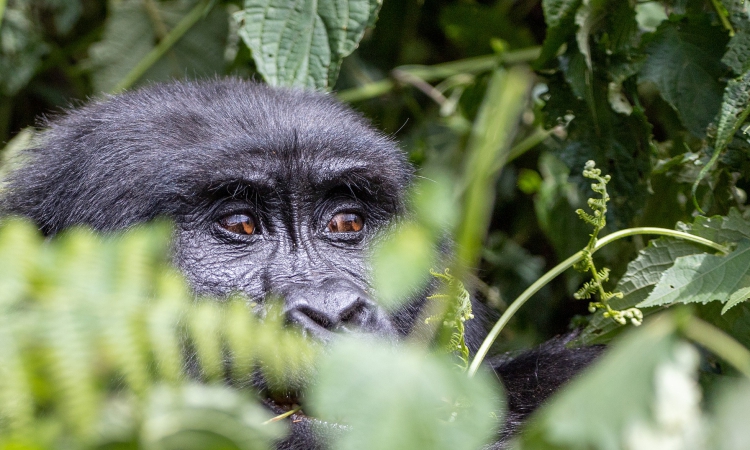Mountain gorilla defense mechanisms – Defense mechanisms are defined as unintentional psychological mechanisms that alleviate distress from an unbearable, harmful stimulus.
The population of mountain gorillas is currently 1,063 individuals, and trekking is carried out within three countries.
In Uganda, there are two gorilla trekking destinations: Bwindi Impenetrable National Park and Mgahinga National Park.
In Rwanda, gorillas are trekked in Volcanoes National Park, and in the Democratic Republic of Congo, gorillas are trekked within Virunga National Park.
Mountain Gorilla Predators

When encountering mountain gorillas in the jungle, one might assume that these apes cannot be threatened considering their massive bodies.
However, the truth is, mountain gorillas have predators that threaten them in their natural habitat.
Although mountain gorillas are humble primates, their survival still remains threatened, yet they are creatures with a very low reproduction rate.
Below are the top predators that threaten mountain gorillas.
- Humans: Humans have also become a great threat to mountain gorillas due to the numerous activities they carry out. People have constantly changed the environment for different reasons like carrying out agriculture, illegal hunting, and fighting wars, and some of these activities lead to climate change, which is also a major threat to mountain gorilla habitat. Humans are also a threat to mountain gorillas in terms of spreading diseases to them since these primates share 98% of their genetic DNA with humans.
- Leopards: Leopards are one of the main mountain gorilla predators in the wilderness. They are very intelligent, and being carnivorous animals, they can kill an adult mountain gorilla. They are capable of climbing trees, which makes it difficult for mountain gorillas to be safe, even when they try hiding up in trees. Leopards, being tree-climbing predators, take advantage of this to attack mountain gorillas, especially at night when they are less aware. Leopards normally target young mountain gorillas and not the adult silverbacks, but they can steadily hunt down the Western lowlands.
- Crocodiles: Crocodiles are also predators of mountain gorillas, although mountain gorillas rarely drink water. Crocodiles usually wait for them on water banks during the rare instances they go to drink water and then attack them. Sometimes they wait for them in wetlands and attack them from there.
Defense Mechanisms of Mountain Gorillas

Mountain gorillas have defensive skills. If a predator is detected, they alert others of danger, and the family members collect around their leader, which is the dominant silverback who meets his responsibilities by protecting his family members from danger.
Below are the defense mechanisms used by mountain gorillas to protect themselves from predators.
- Beating Their Chest: Mountain gorillas’ first response to fear or any kind of injury is to beat their chest and stomp their feet while making loud sounds or hooting to instill fear into the predator and to alert other members of the family to flee to safety. Silverbacks beat their chest while standing upright to look taller, thus scaring away predators. The duty of the dominant silverback is to defend the rest of the family from danger. They may go further to break vegetation in the process of scaring away the enemy.
- Their Strong Hands: Mountain gorillas have stocky bodies and strong hands that help them to fight their predators, mostly leopards. They also use their strong arms to move and lift or crush large objects. Their huge size is enough to scare away their enemies, and the dominant silverback usually weighs more than females when it comes to size. So in terms of size, mountain gorillas are bigger than humans and leopards, thus a defense mechanism.
- Displaying and Exposing Their Strong Canine Teeth: When in danger, mountain gorillas also attack while exposing and displaying their strong, powerful, and scary canine teeth to repel their attacker. Their powerful canine teeth can even kill their opponent, especially when inflicting deep wounds. Silverbacks build relationships like fathers in a typical environment, and the females plus infants tend to build strong relationships with silverbacks for defense in case of any danger or when infants are threatened. Blackbacks also help in protecting the family.
- Always Moving and Gathering in Groups: The saying “United we stand” and “divided we fall” suits gorilla families well because they protect themselves by living and moving in groups, making it easier to defend themselves against their enemies such as leopards and poachers. If a silverback is found alone, it can easily be killed, but if they stick together, no one can confront them.
In conclusion, mountain gorillas are not hostile in nature, but if provoked, they can use their defense mechanisms like beating their chest, using their strong arms, and displaying their strong canine teeth to defend themselves against predators.
These gentle giants also have predators that threaten them in their natural habitat, for example, humans and leopards.










